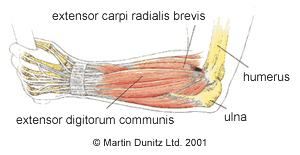| Common Signs & Symptoms | |||||
| Pain | Swelling | Stiffness | Weakness | Instability | Locking |
Tennis Elbow Injury Explained
Tennis Elbow (Lateral Epicondylitis) is a common cause of elbow pain. Tennis Elbow is characterised by pain over the outer side of the elbow, which may radiate down the forearm. Despite the name, Tennis Elbow does not just afflict tennis professionals. In fact, this common elbow problem (it affects about 3% of the population) is most often associated with work-related activities, although racquet sports players are more prone to the condition and account for approximately 5% of all sufferers. Tennis Elbow is equally common in men and women, peaking in prevalence between the ages of 30 and 50.


Tennis Elbow usually begins as inflammation of the extensor tendons of the forearm as they attach to the Humerus (upper arm) bone, just above the elbow joint and function to bend the wrist back (extend). Typically this inflammation is caused by prolonged gripping activities such as hammering, driving screws, weight lifting, playing certain musical instruments, typing, canoeing, digging in the garden, driving and, of course, racquet sports.
If these activities are continued, then the inflammatory nature of Tennis Elbow can give rise to a chronic tendon problem that is characterised by pain, weakness and degeneration of the tendon. This elbow problem can then be very persistent and much more difficult to treat.
Tennis Elbow Signs & Symptoms
Tennis Elbow is very easy to diagnose. There is pain when the Lateral Epicondyle (outermost part of the elbow) is touched, and also if the elbow is straight and the hand is moved forward and back at the wrist. The elbow pain is made worse by gripping activities and, in some cases, simple things like turning a door handle or picking up a kettle can cause intense pain.
Tennis Elbow is differentiated from osteoarthritis of the elbow joint by x-ray investigation. Rheumatoid disease would usually affect more than one joint and is confirmed by blood tests. Pain in the elbow region can be referred from a problem in the neck or shoulder and these should be thoroughly examined in order to eliminate them before a diagnosis of Tennis Elbow is made.
Tennis Elbow Treatment
What you can do
| Consult a sports injury expert | |
| Use anti-infammatory gel for pain relief | |
| Apply ice packs/cold therapy | |
| Wear a compression strap to reduce painful stresses | |
| Use resistance bands for strengthening exercises |
Since severe Tennis Elbow is an inflammatory condition, the obvious treatment would be a short course of non-steroidal anti-inflammatory drugs ( NSAIDs), prescribed by a doctor. Anti-Inflammatory Gel can also be helpful to relieve Tennis Elbow pain. Some doctors may even inject the affected area with a corticosteroid (a naturally occurring substance which can settle down inflammation).
Ice Packs are a cheap and effective treatment for Tennis Elbow, applied for ten minutes every couple of hours (never apply ice directly to the skin). The Aircast Elbow Cryo/Cuff is the most effective method of providing ice therapy is the professional’s choice. It can provide continuous ice cold water and compression for 6 to 8 hours to significantly reduce pain and inflammation.
In addition to anti inflammatory treatments, it is important that the patient reduces the strain on the painful area, otherwise the treatments can simply mask the pain while the condition gets worse. Ideally the patient should rest from aggravating activities for around two weeks to allow the inflammation to settle down. If it’s not possible to rest completely then a Compression Strap (elbow support) is very effective at reducing the stress on the painful area, whilst allowing the user to continue with activities. A Wrist Splint may also help reduce excessive movement of the wrist, allowing the inflammation to resolve. Often desk jobs where a lot of typing is carried out can aggravate this condition and a wrist splint or support to reduce the amount of wrist extension needed can serve as a long term solution to this overuse injury.
Once the severe elbow pain has subsided rehabilitation under the supervision of a Chartered Physiotherapist can cure the problem and prevent a recurrence. A progressive strengthening programme using Resistance Bands has been shown to be the best long term approach to Tennis Elbow.
In some cases of Tennis Elbow, conservative treatment can prove ineffective. This usually occurs in very longstanding cases, where the pain has been present for more than six months and where provocative movements can’t be limited or modified. In these cases, the inflammatory nature of the condition gives way to a chronic degeneration of the tendons of the extensor muscles.
This degeneration can be further exacerbated by long term use of NSAIDs and corticosteroid injections. For this reason, these should be avoided in longstanding cases. In these chronic, degenerative cases, where conservative treatment has not helped, then an orthopaedic surgeon may consider surgery to cure the problem.
Tennis Elbow Prevention
What you can do
| Wear a compression strap to reduce stresses |
Tennis elbow is caused by gripping activities, and gripping either too hard or for too long can bring on the pain. Make sure the item that you are gripping, whether it’s a tennis racquet, bike handles, a hammer, or a canoe paddle, is the correct size for your hand. If it is too small it will cause you to grip too hard. If you play a racquet sport for the first time in a long while or you have to decorate a room in one weekend, make sure you take regular breaks and stretch the muscles which work over the wrist by doing ‘limp wrist’ and ‘policeman halting traffic’ type stretches.
For those who have suffered from Golfers Elbow in the past it may be a good idea to wear a Compression Strap (elbow support). These work by reducing the strain on the painful area by preventing the wrist muscles from contracting fully during sporting and work activities.


